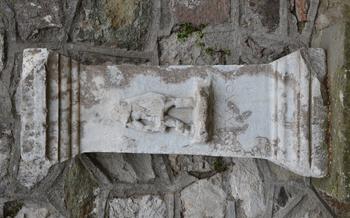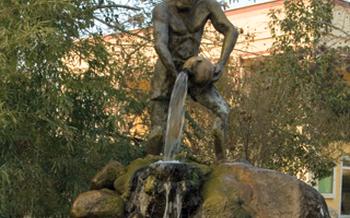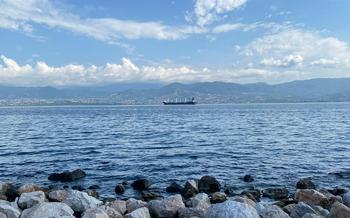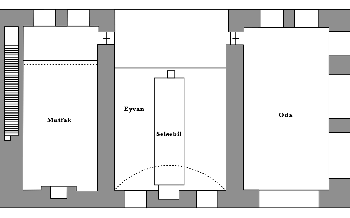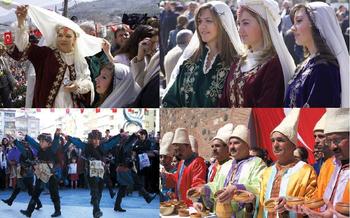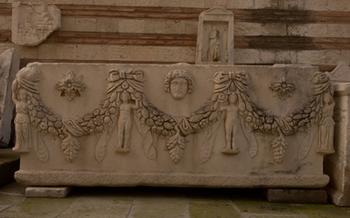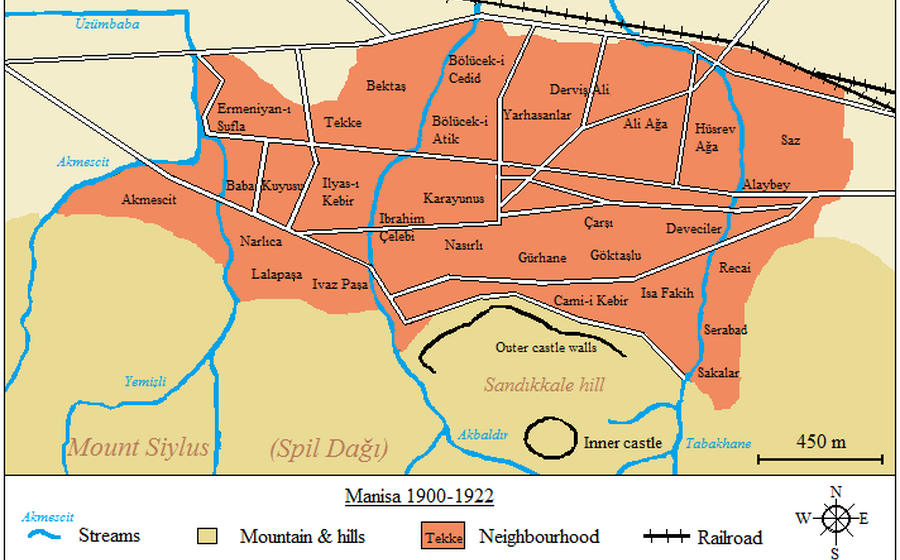
The Historical House of Atatürk in Manisa
- The Historical House of Atatürk in Manisa: A Legacy of National Pride
- Architecture and Design: A Blend of Traditional and Modern Styles
- Rooms and Exhibits: A Showcase of Atatürk's Life and Achievements
- Personal Touches: Glimpses into Atatürk's Daily Life
- Historical Significance: A Symbol of National Unity and Independence
- Preservation and Restoration: Safeguarding a National Treasure
- Guided Tours: An Immersive Experience into Atatürk's Legacy
- Location and Accessibility: A Convenient Destination for History Seekers
- Visitor Information: Planning Your Visit to the House
- Events and Programs: Celebrating Atatürk's Legacy
- Photography and Videography: Capturing Memories of the House
- Souvenirs and Merchandise: Mementos from the Historical House
- Nearby Attractions: Exploring Manisa's Cultural Heritage
- Recommended Tours: Hassle-Free Exploration with Local Guides
- Insider Tip: Unveiling Hidden Gems
The Historical House of Atatürk in Manisa: A Legacy of National Pride
The Historical House of Atatürk in Manisa stands as a testament to the life and legacy of Mustafa Kemal Atatürk, the revered founder of the Republic of Turkey. Built in the late 19th century, the house served as Atatürk's headquarters during the Turkish War of Independence. It was here that he orchestrated the strategic military operations that led to Turkey's victory and the establishment of the modern Turkish state. Today, the house is a meticulously preserved museum, inviting visitors to delve into the history and significance of one of Turkey's most influential figures. Its historical value and symbolic importance make it a national heritage site that resonates deeply with Turkish identity and the nation's pride in its independence.
Architecture and Design: A Blend of Traditional and Modern Styles
The Historical House of Atatürk in Manisa stands out for its unique architectural features, which blend traditional Ottoman elements with modern European influences. The house, built in the early 19th century, showcases a harmonious fusion of architectural styles, reflecting Atatürk's vision of combining Turkey's rich cultural heritage with progressive ideas from the West.
The exterior of the house features intricate stonework, arched windows, and a grand entrance, reminiscent of traditional Ottoman architecture. The interior, however, reveals a more modern aesthetic, with spacious rooms, high ceilings, and large windows that allow ample natural light to flood in.
The house's design is not merely an aesthetic choice but also holds symbolic meaning. The blend of traditional and modern elements represents Atatürk's efforts to bridge the gap between Turkey's past and its future, embracing progress while honoring the nation's cultural roots. The house's architecture, like Atatürk's own vision for Turkey, symbolizes a synthesis of tradition and modernity, creating a unique and forward-looking identity for the nation.
Rooms and Exhibits: A Showcase of Atatürk's Life and Achievements
The Historical House of Atatürk in Manisa is a treasure trove of artifacts, documents, and personal belongings that shed light on the life and accomplishments of the revered Turkish leader. The house is divided into several rooms, each dedicated to a different aspect of Atatürk's remarkable journey.
The entrance hall sets the tone for the visit, with a grand staircase leading to the upper floors. The walls are adorned with portraits of Atatürk and his contemporaries, along with historical maps and documents.
The main living area, known as the "salon," is a testament to Atatürk's refined taste and appreciation for both traditional and modern styles. Comfortable sofas and armchairs surround a central fireplace, while ornate chandeliers hang from the high ceiling.
Atatürk's study is a reflection of his intellectual pursuits and tireless work ethic. The room is lined with bookshelves filled with volumes on history, politics, and military strategy. A large desk dominates the center of the room, where Atatürk spent countless hours planning and strategizing.
The house also features a dining room, where Atatürk hosted official guests and held important meetings. The room is decorated with elegant furniture and tableware, reflecting the formal nature of these gatherings.
Throughout the house, visitors can find personal items that offer glimpses into Atatürk's daily life. His uniforms, medals, and decorations are displayed alongside his favorite books, paintings, and photographs. These artifacts provide a tangible connection to the man who shaped the course of Turkish history.
The Historical House of Atatürk is more than just a museum; it is a repository of Turkey's modern history. The exhibits and artifacts within its walls tell the story of a nation's struggle for independence and the visionary leadership that guided it to victory.
Personal Touches: Glimpses into Atatürk's Daily Life
Beyond its historical significance, the Historical House of Atatürk in Manisa offers visitors a unique glimpse into the personal life and habits of the revered leader. The furniture, decorations, and artwork within the house reflect Atatürk's personal preferences and provide insights into his daily routine. His study, bedroom, and other private spaces are meticulously preserved, allowing visitors to imagine Atatürk engaged in his work or relaxing in the comfort of his home.
Anecdotes and stories shared by guides and docents bring Atatürk's personality to life. Visitors can learn about his favorite books, his love for music, and his daily habits. The house serves as a testament to Atatürk's character and personality, showcasing his human side beyond his role as a military leader and statesman.
One particularly intriguing anecdote relates to Atatürk's fondness for Raki, a traditional Turkish alcoholic beverage. It is said that he would often enjoy a glass of Raki in the evenings, accompanied by close friends and colleagues. The house's dining room features a table where Atatürk and his guests would gather for lively discussions and camaraderie.
By exploring the personal touches within the Historical House of Atatürk, visitors gain a deeper understanding of the man who shaped the course of Turkish history. They come away with a sense of connection to Atatürk, recognizing him not only as a national hero but also as a complex and multifaceted individual.
Historical Significance: A Symbol of National Unity and Independence
The Historical House of Atatürk in Manisa holds immense historical significance as a symbol of Turkey's struggle for national unity and independence during the Turkish War of Independence. In 1919, Mustafa Kemal Atatürk, the founder of the Republic of Turkey, chose Manisa as his headquarters due to its strategic location and strong support from the local population. The house served as the center of command and coordination for the Turkish forces during the war.
Atatürk's decision to establish his headquarters in Manisa was a testament to the city's importance in the national struggle. Manisa, located in western Turkey, was a hub of resistance against the occupying forces and a stronghold of the Turkish nationalist movement. The city's strategic location, close to the Aegean coast and surrounded by mountains, provided a safe haven for the Turkish forces to plan and execute their military operations.
From the Historical House of Atatürk, Atatürk and his fellow commanders strategized and directed the Turkish forces in their battles against the invading Greek army. The house witnessed countless meetings, discussions, and decisions that shaped the course of the war. It was here that Atatürk issued his famous "Manisa Circular" in 1919, calling for the mobilization of the Turkish people against the occupation.
The house, therefore, stands as a symbol of Turkey's determination to achieve independence and sovereignty. It represents the unity and resilience of the Turkish people in their fight against foreign aggression. Today, the Historical House of Atatürk is not only a museum but also a national heritage site that evokes a sense of pride and patriotism among Turks, reminding them of the sacrifices made by their ancestors in the pursuit of freedom.
Preservation and Restoration: Safeguarding a National Treasure
The Historical House of Atatürk, a symbol of Turkey's national identity and independence, has undergone extensive preservation and restoration efforts to ensure its longevity and authenticity. The government, in collaboration with cultural institutions, has taken meticulous steps to maintain the integrity of the building while preserving its historical significance.
Challenges in preserving the house include the need for specialized techniques to restore the original architectural features, as well as the ongoing battle against the effects of time and wear. However, these challenges are met with unwavering dedication, as the house holds immense cultural and historical value for the Turkish people.
The preservation efforts extend beyond the physical structure to include the artifacts and personal belongings of Atatürk. These items, ranging from furniture and artwork to documents and clothing, have been meticulously cataloged and preserved to provide visitors with a glimpse into the life and times of the beloved leader.
The Historical House of Atatürk stands as a testament to Turkey's commitment to safeguarding its national heritage. Through ongoing preservation and restoration efforts, this iconic landmark continues to inspire future generations and serves as a reminder of the resilience and determination that shaped the nation's history.
Guided Tours: An Immersive Experience into Atatürk's Legacy
Step into the world of Mustafa Kemal Atatürk, the revered father of modern Turkey, through guided tours of his historical house in Manisa. Led by knowledgeable guides fluent in various languages, these tours offer an immersive experience that transports visitors back in time.
Guides provide historical context and fascinating anecdotes, shedding light on Atatürk's life, achievements, and the significance of the house during the Turkish War of Independence. Multimedia presentations and interactive displays further enhance the experience, bringing Atatürk's legacy to life.
Guided tours are essential for delving into the intricacies of Atatürk's life and contributions. They offer a deeper understanding of the house's role in shaping Turkish history and a glimpse into the personal side of one of the most influential figures of the 20th century.
Location and Accessibility: A Convenient Destination for History Seekers
The Historical House of Atatürk is conveniently located in the heart of Manisa, a city in western Turkey known for its rich history and cultural heritage. The exact address of the house is Cumhuriyet Caddesi, No: 6, Manisa Merkez. Visitors can easily reach the house by car, public transportation, or on foot. For those driving, there are ample parking facilities available in the vicinity. If you prefer to use public transportation, you can take a bus or minibus to the Cumhuriyet Meydanı stop and walk a short distance to the house. The house is also accessible for visitors with disabilities, with ramps and elevators available for easy access throughout the building.
Visitor Information: Planning Your Visit to the House
To make the most of your visit to the Historical House of Atatürk in Manisa, it is essential to plan your trip carefully. The museum is open to the public from 8:30 am to 5:00 pm daily, except on Mondays. Admission fees are minimal, and tickets can be purchased at the entrance. Audio guides in various languages are available for rent, and multilingual brochures are provided to enhance your understanding of the exhibits.
It is recommended to allocate at least two hours for a comprehensive visit to the house and its grounds. Start your tour by exploring the exterior architecture, taking in the unique blend of Ottoman and European styles. Proceed inside to discover the various rooms, each offering a glimpse into Atatürk's life and achievements. Take your time to read the informative displays and examine the artifacts on display.
For a deeper understanding of the house's historical significance, consider joining a guided tour. Knowledgeable guides provide insightful commentary and anecdotes, bringing Atatürk's story to life. Interactive tours using multimedia presentations are also available, offering an immersive experience for visitors.
Events and Programs: Celebrating Atatürk's Legacy
The Historical House of Atatürk in Manisa serves as a prominent venue for events, exhibitions, and conferences that celebrate the legacy of Mustafa Kemal Atatürk and promote Turkish history and culture. These events offer unique opportunities for visitors to gain deeper insights into Atatürk's life, contributions, and the significance of the house in Turkey's modern history.
Commemorations of Atatürk's birthday and other national holidays are held at the house, featuring special ceremonies, speeches, and cultural performances that honor his memory and the principles he stood for. These events provide a platform for the Turkish people to express their gratitude and respect for the founder of their republic.
Educational programs and workshops are also organized at the house, catering to students, researchers, and the general public. These programs aim to educate participants about Atatürk's life, the Turkish War of Independence, and the country's transition to a modern nation-state. Interactive sessions, lectures, and hands-on activities provide a dynamic and engaging learning experience.
Through these events and programs, the Historical House of Atatürk in Manisa becomes a vibrant hub for preserving, promoting, and celebrating Turkey's rich cultural heritage. It offers visitors a chance to connect with the past, honor the legacy of a great leader, and gain a deeper understanding of Turkey's journey towards becoming a modern nation.
Photography and Videography: Capturing Memories of the House
Guidelines and Restrictions:
-
Photography and videography are generally allowed within the Historical House of Atatürk, but certain guidelines and restrictions apply.
-
Designated areas for photography are marked throughout the house, while certain sections may have restrictions due to preservation concerns.
-
Visitors are requested to be respectful of other visitors and avoid disturbing the peaceful atmosphere of the museum.
Capturing the Best Shots:
-
To capture the best angles and lighting, plan your visit during the morning or late afternoon when natural light is most favorable.
-
Use a wide-angle lens to capture the grandeur of the house's interiors, and a telephoto lens for detailed shots of specific artifacts or architectural features.
-
Experiment with different angles and perspectives to create unique and visually interesting photographs.
Sharing Your Memories:
-
Share your photos and videos on social media using the official hashtags of the museum to connect with other visitors and enthusiasts.
-
Tag the museum's official social media accounts to increase the visibility of your content and contribute to the promotion of Atatürk's legacy.
Preserving the Legacy:
-
By purchasing souvenirs and merchandise related to Atatürk and the house, you can support the ongoing preservation efforts and help ensure that this national treasure continues to inspire future generations.
-
Consider buying books, replicas, or other items that are not only mementos of your visit but also contribute to the preservation of Atatürk's legacy.
Souvenirs and Merchandise: Mementos from the Historical House
The Historical House of Atatürk offers a variety of souvenirs and merchandise that allow visitors to take home a piece of their experience. The museum gift shop is a treasure trove of unique and meaningful mementos, from books and postcards to replicas of artifacts and artwork. These souvenirs not only serve as reminders of the house and Atatürk's legacy but also support the ongoing preservation efforts.
For those unable to visit the house in person, an online shopping option is available, allowing history enthusiasts from around the world to purchase souvenirs and contribute to the preservation of this national treasure. Whether you choose to purchase a commemorative mug, a replica of Atatürk's signature, or a book detailing his life and achievements, your purchase will help ensure that the legacy of the Father of Modern Turkey continues to inspire future generations.
Nearby Attractions: Exploring Manisa's Cultural Heritage
While delving into the history of the Turkish Republic at the Historical House of Atatürk, don't miss the opportunity to explore the rich cultural heritage of Manisa and its surroundings. The city boasts a treasure trove of museums, historical sites, and cultural landmarks that offer a glimpse into its diverse past.
The Manisa Museum, located in the heart of the city, houses an impressive collection of artifacts from the region's ancient civilizations, including the Hittites, Lydians, and Romans. The museum's exhibits showcase the artistic and cultural achievements of these ancient peoples, providing visitors with a deeper understanding of the region's roots.
For those interested in religious architecture, the Sultan Mosque and the Muradiye Mosque are must-visit attractions. These magnificent structures, with their intricate tilework and soaring minarets, are testaments to the city's Islamic heritage. Visitors can marvel at the beauty of these architectural masterpieces while learning about the religious traditions and practices of the local community.
Manisa is also renowned for its vibrant culinary scene, where visitors can indulge in traditional Turkish cuisine. From the aromatic kebabs and gözleme to the delectable Turkish delight and lokum, the city's restaurants offer a feast for the senses. Be sure to sample the local specialty, Manisa kebabı, a succulent grilled meat dish that is sure to tantalize your taste buds.
For a refreshing break from the city, take a day trip to the nearby natural wonders. The Spil Mountain National Park, located just a short drive from Manisa, offers breathtaking landscapes, lush forests, and cascading waterfalls. Visitors can hike through the park's scenic trails, enjoy a picnic by the river, or simply relax and soak in the tranquility of nature.
To make the most of your visit to Manisa, consider creating a comprehensive itinerary that allows you to explore the city's historical sites, cultural landmarks, and natural attractions. With so much to see and experience, Manisa promises a memorable and enriching journey into Turkey's rich past and vibrant present.
Recommended Tours: Hassle-Free Exploration with Local Guides
For a hassle-free and enriching experience, consider joining an organized tour or day trip to the Historical House of Atatürk. Several reputable tour operators offer guided excursions from major cities in Turkey, ensuring a comprehensive and informative visit.
The advantages of joining a guided tour are numerous. Experienced local guides provide valuable historical context, share captivating anecdotes, and offer insights into Atatürk's life and legacy. They can navigate the house efficiently, ensuring you don't miss any significant exhibits or hidden gems.
When selecting a tour operator, conduct thorough research and read reviews from previous travelers. Look for companies with a good reputation, knowledgeable guides, and a focus on providing a personalized and engaging experience.
Many tour operators offer online booking options, allowing you to plan your trip in advance and secure your spot. Consider your interests and budget when choosing a tour, as some may include additional activities or visits to nearby attractions.
By opting for a guided tour, you can relax and fully immerse yourself in the history and significance of the Historical House of Atatürk, without the hassle of planning logistics or navigating the city on your own.
Insider Tip: Unveiling Hidden Gems
Beyond the main exhibits and well-known attractions, the Historical House of Atatürk holds hidden treasures waiting to be discovered. For those seeking a deeper connection with the house and its history, here are some insider tips:
-
Secret Room: In a secluded corner of the house, a hidden room offers a glimpse into Atatürk's private sanctuary. This room, once used for confidential meetings and personal contemplation, is now accessible to visitors who inquire about its existence.
-
Unseen Artifacts: While the main exhibits showcase some of Atatürk's most iconic belongings, there are lesser-known artifacts hidden away in the house's archives. Ask the museum staff about these hidden treasures, and they may be able to arrange a special viewing for you.
-
Local Delights: Manisa is renowned for its culinary delights, and visitors can savor authentic Turkish cuisine at local restaurants near the house. Ask your guide or a local resident for recommendations on where to find the best kebabs, gözleme, and Manisa's famous mesir paste.
-
Hidden Viewpoints: The house offers stunning views of the surrounding landscape, but there are secret viewpoints that provide even more breathtaking panoramas. Explore the gardens and terraces to find these hidden spots and capture unforgettable photographs of Manisa's beauty.
Remember, these insider tips are just a starting point. With a keen eye and a willingness to explore beyond the surface, you'll discover the hidden gems that make the Historical House of Atatürk a truly special place.
